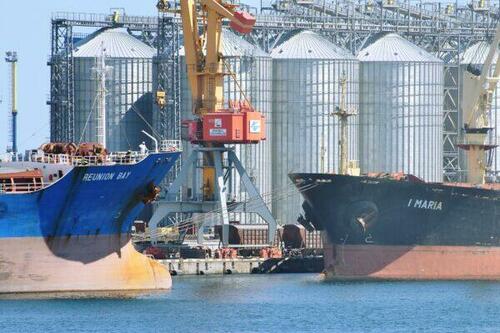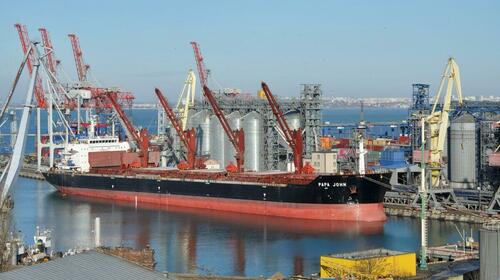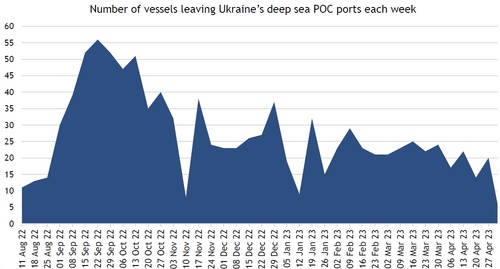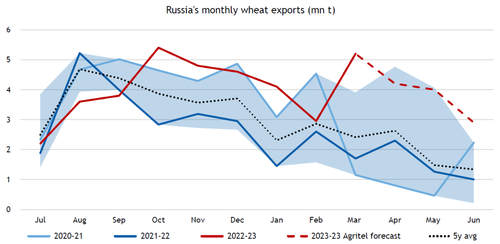(Ils ont crié "Il faut ouvrir le port d'Odessa, ce n'est pas possible de transporter les céréales ni par train, ni par camion, trop compliqué, trop cher. En ce moment, le port d'Odessa est fermé et ils sont en train d'inonder les marchés de l'europe de l'est de céréales ukrainiennes qui viennent par camions au point de faire exploser leurs marchés à cause de leur prix très concurrentiels, trop disent les agriculteurs polonais. En France, la capitale Paris et ses alentours sont ravitaillés par le marché international de Rungis et toutes les marchandises y parviennent par camions, même d'Italie, d'Espagne ou de Pologne. Mais, évidemment cela rogne un peu le profit de vanguard ou black rock. note de rené)
What Will Happen If Russia Blocks Black Sea Grain Ships?
By Greg Miller of FreightWaves,
Russia is threatening to pull the plug on the Black Sea Grain Initiative on May 18, blocking Ukrainian seaborne exports of corn and wheat. The European Union has banned Ukrainian agriculture exports to neighboring Romania, Bulgaria, Poland, Hungary and Slovakia until June 5, with an extension through year-end possible, due to local pricing pressures. The Tolyatti-Odessa pipeline, a key conduit for Russian exports of ammonia — a vital fertilizer feedstock — remains offline.
CNBC recently warned that “the basic food security of tens of millions across the globe is hanging by a thread.” The United Nations stressed that the Black Sea Grain Initiative is “critical” and helps “stave off famine.”
Prices of agricultural products and fertilizers spiked after Russia’s invasion of Ukraine. Is the world headed for a new food-inflation crisis?
Not this time, according to commodity price-reporting agency Argus. Global trade flows have evolved over the past 14 months, adjusting for the war risk. Ocean shipping has come to the rescue, plying new routes: from bulkers carrying wheat, corn, and fertilizers to liquefied petroleum gas (LPG) carriers loaded with ammonia to product tankers transporting sunflower oil.
“Markets find a way,” said Mike Nash, senior editor of fertilizer markets at Argus, during a presentation on Thursday. Geopolitical impacts have already “largely played out,” he said.
New threats not lifting commodity prices
Ukraine’s role in global markets has eroded even as its exports moved overland to neighboring countries and left by ship though the Black Sea corridor. Consequently, a loss of Ukrainian exports now would have much less impact on buyers than it did when the war broke out.
The proof is in the prices. Not only are agricultural commodity prices down sharply from the post-war peak, they’re not rising as new threats to Ukrainian exports emerge.
According to Jade Delafraye, Argus’ global editorial manager for agriculture, “The situation in Ukraine has had a large impact on the grains, oilseeds and veg-oil markets over the last year or so. But at the moment, the share of Ukraine in the supply of those markets has been greatly reduced. And these markets are well supplied.
“Therefore, the concerns and uncertainties about whether Ukraine will be able to continue exporting are not currently sufficient to lift prices.”
A meeting of Black Sea corridor technical staff was held Friday in Istanbul to discuss the extension of the deal. No agreement was reached.
The number of Black Sea transits from Ukraine has fallen even before a decision on extending the corridor agreement. Only six vessels left Ukrainian ports in the most recent week. “This is down sharply from where we were a few months ago, with a peak of 55 ships [in a week] back in September,” noted Delafraye.
Russian wheat exports hitting record levels
When the ports were closed in the early days of the war, Ukraine exported its wheat, corn and barley by land through Romania, Hungary, Slovakia and Poland. Starting last August, it began exporting grains — primarily corn — via the Black Sea corridor.
Wheat prices initially spiked after war broke out and then “came tumbling down,” said Delafraye.
The return of Ukrainian exports was not the main driver in the drop. Bumper wheat crops in Russia and Australia were the primary factors. “Russia has been able to export at record levels and gain market share,” she said.
The U.S. Department of Agriculture currently projects global wheat exports will total 212.7 tons in the 2022-23 marketing year (which ends June 30), up 5% year on year. Russia is the largest exporter, predicted to ship 45 million tons — a 36% year-on-year surge.
Worst-case scenario for Ukrainian exports
Delafraye addressed a worst-case scenario in which Ukraine seaborne exports go to zero. Even in that case, “there are no real concerns … on whether the global market could cope without Ukrainian volumes,” she said.
For the current marketing year, there are “ample [wheat] volumes left to be exported” from Russia, Romania, Bulgaria, Canada and Australia. For the 2023-24 marketing year, strong ending stocks should allow the EU, Russia and Australia to ramp up exports to cover the wheat shortfall, she added.
Corn prices fell from their post-invasion peak as well, “although not as much as wheat, despite the fact that the majority of the Ukrainian exports through the corridor and by land have been corn exports,” Delafraye said.
If Ukrainian corn exports were blocked, she said, replacement volumes could be exported by the U.S., Brazil and Argentina. “We expect another bumper crop to come out of Brazil,” she said.
“On the corn side, again, the loss of Ukrainian volumes in a worst-case scenario could be compensated for elsewhere. What happens with the corridor at the moment no longer moves prices and the world would be able to cope.”
Shipping effect of Black Sea corridor
“Global corn and wheat prices have continued to decline and have now fallen below pre-war levels, indicating an improvement in cargo availability,” said ship brokerage Braemar in a research note on Thursday.

According to Braemar, China has been the single largest destination for ships carrying Ukrainian grain through the Black Sea corridor, followed by countries in Western Europe, and to a lesser extent, North Africa, India and Bangladesh.
A total of 764 dry bulk vessels carrying 27.8 million tons of grain have departed Ukraine since the beginning of the Black Sea Grain Initiative.
Braemar said 386 or 50% of the ships have been have been Handysizes (smaller bulkers with capacity of 10,000-39,999 deadweight tons or DWT), 216 or 28% have been Panamaxes (58,000-78,999 DWT) and 162 or 22% have been Supramaxes or Ultramaxes (50,000-69,999 DWT).
The majority of exports to China have been transported aboard Panamaxes, creating “a significant additional long-haul trade for the sector,” said Braemar.
Shipping demand is measured in ton-miles (volume multiplied by distance). An end to the Black Sea initiative is not necessarily negative for shipping demand. More Brazilian and Argentinian corn cargoes to China would be a positive for ton-miles, as would more Australian wheat cargoes headed west and more Canadian cargoes headed east.
Ban on exports to neighboring EU countries
Meanwhile, concerns are also being raised about the recent ban on Ukrainian exports to neighboring EU countries, where local farmers are rebelling as the glut cuts their income.
Delafraye said that this should not have a significant effect on international markets, because the agreements still allow Ukrainian cargoes to transit these countries for export.
The majority of Ukraine’s cross-border trade has gone to Romania, with about 70% of those volumes then re-exported, according to Argus data.
“So, as long as transit remains possible through these countries, and that’s the situation we seem to be in, the impact on the global market should be limited,” said Delafraye.
‘Myths’ on Russian fertilizer threat
Food security fears in the wake of the invasion were not just about the loss of Ukrainian grains. They were also about loss of access to Russian fertilizers and fertilizer raw materials.
“Concerns were very, very real because Russia is a major supplier,” said Nash.
Fertilizer prices were already very high when Russia invaded Ukraine, and skyrocketed after military action, with the phosphorus fertilizer DAP topping $1,200 per ton at one point.
But as with the wheat and corn, fertilizer prices then fell back. “Prices trailed off in the second half of 2022. It was significant and relatively quick,” Nash said. “The market reacted as new supply sources opened up and Russian materials continued to flow. In many cases, supply increased, so the concern dissipated.”
Russian exports of DAP and the other main phosphorus fertilizer, MAP, rose in 2022 versus 2021. “Combined exports increased by well over 4 million tons. This myth that phosphate supply was curtailed is simply not true. Russia actually exported more,” said Nash.
US buys more Russian fertilizer
Russian urea exports increased 10% in 2022 versus 2021. Higher Russian volumes to India and Turkey mirror moves in the oil and diesel markets. What’s surprising is that Russia also sold more urea to the U.S., the Netherlands, France and Germany.
“Another of the myths is that European and Western entities turned their back on Russian [fertilizer]. That did not happen,” said Nash. “There are no sanctions on Russian [fertilizer] products. It is in theory free to move everywhere — and it has.
“For all the concerns in the mainstream media about the loss of supply of Russian fertilizer, it simply did not happen.”
As with grains, the proof of availability is in the prices. They’re falling. “The story for pretty much all the products in the finished fertilizer market is weak prices [that] are expected to edge down,” he said. “The market has adapted. New trade flows have emerged. There is plenty [of fertilizer] around the world.”
Fertilizer shipping markets: Tankers and bulkers
The war’s biggest and most immediate effect on fertilizer markets was the closure of the Tolyatti-Odessa ammonia pipeline. “That was shut off straight away, losing 240,000 tons per month of ammonia overnight. That had a huge impact on prices,” said Nash.
Russia was supplying the EU with 100% of its ammonia imports at the time the war broke out. This is yet another instance where ocean shipping solved the problem. Global trade flows shifted to new routes, offsetting the pipeline loss. Ammonia prices are now back to pre-war levels.
Ammonia is typically carried aboard smaller LPG tankers in the Handysize category. Short-haul shipments from Odessa have been replaced by long-haul shipments from China, Australia, the Middle East and the U.S. Gulf.
The new trade patterns are “leading to an increase in ton-mile demand for our vessels,” said Navigator Holdings (NYSE: NVGS). Ten of its Handysizes — a third of its Handysize tanker fleet — were carrying ammonia during the latest quarter.
In dry bulk shipping, most fertilizer is carried on bulkers with capacities of 3,000-60,000 DWT, particularly in the 25,000-39,999 DWT range, said ship brokerage BRS in a March overview of the trade.
Fertilizer has been a mixed bag for dry bulk shipping. On one hand, freight rates for Russian cargoes spiked after the war and remain above pre-invasion levels. On the other, global dry bulk fertilizer exports fell 9% in 2022 versus 2021, said BRS. China and Morocco sharply reduced exports, with China intentionally limiting outflows to protect domestic supplies in the wake of last year’s price spike.
Lower prices in 2023 “could give some spring to fertilizer trade flows later this year, providing much-needed respite to geared bulkers,” said BRS.
Russian takes more market share
Add it all up and Russia emerged as a big winner amid all the post-war shifts in the agribulk and fertilizer trades.
The country faces sanctions in the crude and diesel markets, but given humanitarian concerns, sanctions are off the table when it comes to food and fertilizer commodities. Even America buys Russian fertilizer.
Since the war began, Russia has increased its market share and sales of wheat, as well as urea, DAP and MAP. If it blocks the Black Sea Grain Initiative, it could sell even more wheat at Ukraine’s expense.
The damage to Ukraine’s role in global markets has already been done. The loss of the corridor would intensify the fallout to its economy, further solidifying new trading patterns.
“All in all, it could take years for Ukraine to regain its previous place in global agricultural markets should the conflict come to an end,” said Delafraye.



Aucun commentaire:
Enregistrer un commentaire